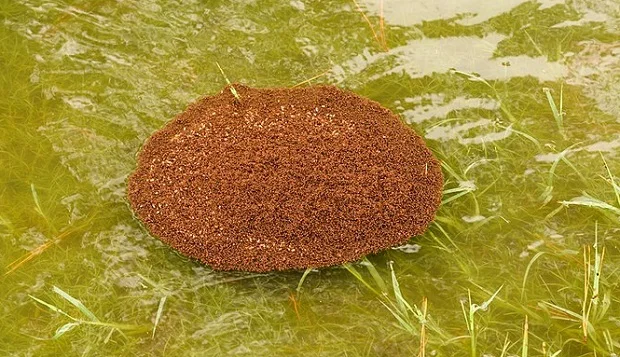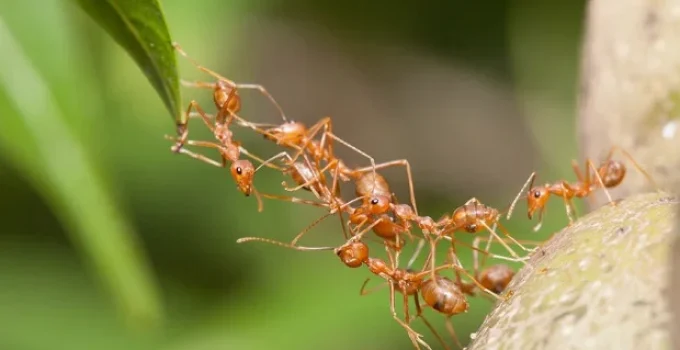Can Ants Swim?
Yes, some ants can swim, but their aquatic abilities vary widely by species. While many ants can survive short periods in water by paddling or floating, only a few are truly adapted for life in wet environments. Most ants avoid water when possible, but when survival calls, their ingenuity and resilience come into play.
🧭 Dive Deeper
- Do All Ants Swim?
- How Do Ants Swim or Stay Afloat?
- Which Ant Species Are Best at Swimming?
- How Do Ants Survive Floods?
- Table: Aquatic Abilities of Different Ant Species
- 🎯 Final Thoughts
- 📚 References
Do All Ants Swim?
Not all ants can swim, but many can survive temporary immersion in water. Ant swimming behavior ranges from:
- Active paddling with legs
- Floating using surface tension
- Clinging to debris or forming rafts
Most ants lack specialized swimming adaptations, so they rely on natural buoyancy and cooperative behavior to survive watery hazards.
🧪 | Stat: In one study, about 75% of ant species tested could remain afloat for at least 24 hours, though not all could swim effectively [1].
How Do Ants Swim or Stay Afloat?
Ants swim by moving their legs in a motion similar to dog paddling. Their lightweight exoskeletons and hydrophobic (water-repellent) surfaces allow many to float on the surface without sinking. In some species, the hairs on their bodies trap air bubbles, increasing buoyancy.
Survival strategies include:
- Treading water with coordinated leg movements
- Using spiracles (breathing holes) sealed off to prevent water entry
- Relying on group behavior, such as linking together to form floating masses
🌊 | Interesting fact: Ants do not drown easily. Many can survive submerged for up to 24 hours by entering a low-metabolism state [2].
Which Ant Species Are Best at Swimming?
Some ant species live in wet environments and are better suited to water than others:
- Fire ants (Solenopsis invicta) are known for their ability to form waterproof living rafts made from their own bodies. These rafts can float for weeks during floods and help the colony relocate.
- Camponotus spp. (carpenter ants) have demonstrated moderate swimming and floating abilities.
- Polyrhachis sokolova, a mangrove-dwelling ant in Australia, is one of the few species that regularly dives underwater to forage in tidal zones [3].
On the flip side, desert ants or strictly arboreal species often avoid water and have poor swimming ability.
How Do Ants Survive Floods?

Ant colonies living in flood-prone areas have developed impressive strategies:
- Raft-building: Fire ants grip one another using claws and jaws to form stable, buoyant rafts that keep the queen and brood dry.
- Nest design: Some ants create mounds with elevated chambers or sealed air pockets.
- Relocation behavior: Colonies may evacuate and rebuild when floods are detected via humidity and vibration cues.
📊 | Stat: Fire ant rafts can support tens of thousands of ants and remain afloat for over 100 hours without disintegrating [4].
These behaviors highlight the ants’ ability to adapt collectively to environmental challenges through evolved social coordination.
Table: Aquatic Abilities of Different Ant Species
| Ant Species | Can Swim? | Notable Adaptation | Survival Strategy in Water |
|---|---|---|---|
| Solenopsis invicta | Yes | Raft-building, waterproof cuticle | Floating rafts with brood in center |
| Polyrhachis sokolova | Yes (dives) | Submergence and tidal foraging | Forages underwater in mangroves |
| Camponotus spp. | Moderate | Moderate paddling ability | Cling to surfaces, float briefly |
| Lasius niger | Poor | Avoids water, limited endurance | Escapes water, relies on surface tension |
| Cataglyphis spp. | No | Desert species | Avoids water entirely |
🎯 Final Thoughts
So, can ants swim? While not all ants can swim, many are surprisingly capable in aquatic situations. Through body structure, buoyancy, and especially cooperative behavior, ants can survive floods, cross streams, and build floating colonies. Some, like fire ants and mangrove ants, even thrive in watery environments. Their resilience in water is yet another example of how ants adapt ingeniously to nearly every corner of the planet.
📚 References
- CNN. (2017). Fire ants form floating rafts to escape floods. https://edition.cnn.com/2017/08/30/health/fire-ant-rafts-harvey/index.html
- Mlot, N. J., Tovey, C. A., & Hu, D. L. (2011). Fire ants self-assemble into waterproof rafts to survive floods. Proceedings of the National Academy of Sciences, 108(19), 7669–7673. https://doi.org/10.1073/pnas.1016658108
- Hölldobler, B., & Wilson, E. O. (1990). The Ants. Harvard University Press.
- Nielsen, M. G. (1997). Polyrhachis sokolova: The swimming ant of Australian mangroves. Journal of Insect Behavior, 10(6), 805–817.
📌Learn More About Ants
- How Do Ants Reproduce?🐜A Deep Dive Into Colony Growth
- Do Ants Have Blood?🐜 The Surprising Truth about Insect Circulation
- Can Ants Smell? 🐜 Exploring the Chemical World of Ant Communication
- Can Ants Swim? 🐜 Exploring the Aquatic Abilities of Earth’s Hardest Workers
- Do Ants Eat Termites? 🐜 The Many Termite Predators
- Do Ants Have Brains? 🐜 Inside the Mind of Nature’s Minature Engineers
- Do Ants Have Muscles? 🐜 Explore What These Muscular Powerhouses Can Do
- Do Ants Sleep? 🐜 Ants Are Supersonic Power Nappers!
- How Long Do Ants Live? 🐜 A Look Into the Lifespan of the Colony
- What Do Ants Eat? 🐜 Inside the Pantry of an Ant Colony
- Are Ants Blind? 🐜How These Tiny Insects See the World
